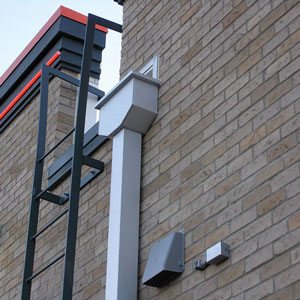The Proper Flat Roof Drainage System Can Help Preserve Your Roof’s Integrity
Flat roofs have a long history in the United States, especially for commercial construction. However, flat roofs depend greatly on proper drainage of rain and snow melt to preserve their integrity. Without it, pooling water can occur and cause leaks, deterioration in the roof membrane and ice formation during winter. These are the three types of drainage systems that work best for flat roofs.
Interior Drains
This drainage system is composed of drains placed at intervals near the center of the roof and an internal network of gutters and pipes that move the water to the exterior of the building. The drains are often topped by a strainer that prevents leaves and debris from getting into the pipes. These are often a good solution for large roofs on which water tends to collect in the center. They are aesthetically pleasing because all of the components are located inside the roof and invisible to someone looking at it from the outside. However, these tend to be more costly to install than exterior drainage systems and represent a significant investment.
Scuppers
Scuppers are outlets placed on the edges of the roof that project water that drains off the roof away from the building. They keep the walls of the building dry and prevent the foundation from being destabilized by too much exposure to water. Scuppers are more cost effective than inner drains, but they work best when all of the water is directed to them using a tapered insulation system or a sloped structure. They are a good solution for areas that frequently get heavy rains, but are not ideal for dealing with snow melt.
Gutters
Gutters are open pipes that are attached to the edges of the roof. They collect water as it drains off the roof and carry it away from the building. They are generally the most cost effective drainage solution since they can be attached to a finished roof without any modification to the roof itself. They are also good at dealing with variable levels of rain and snow. As with drains and scuppers, gutters do regularly need to be cleared of debris and cleaned in order to continue functioning properly.
Deciding what type of drainage is best for your facility should be determined by your engineer or building design team. In addition, you should always make sure that the roofing contractor you hire is experienced in installing all three of these drainage systems. While a proper drainage system design is essential for the overall reliability of the roof, a quality installation ensuring the design is implemented properly is key.
If you are ready to install your roof and drainage system, please call North American Roofing at 866-295-5401 today to schedule an appointment or consultation.

